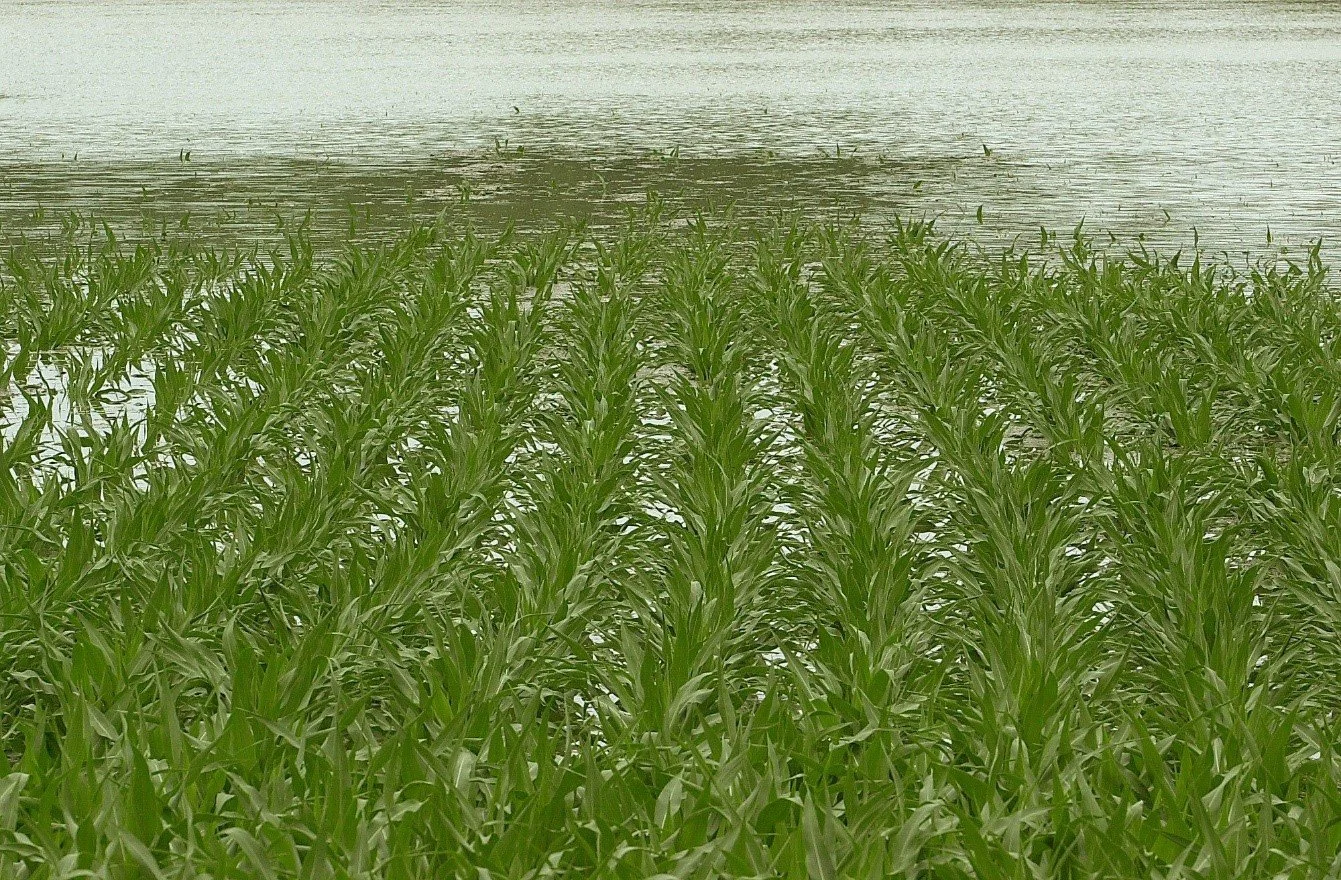Flood Damage to Corn in 2022
Figure 1. Some corn in this field was fully submerged while other was not. The submerged corn likely will not survive. The other corn might. Photo by Greg Drake, Butler County ANR Agent.
Chad Lee, University of Kentucky
Corn in some fields in eastern Kentucky was flooded by recent torrential rain events. If soil temperatures are above 70 F, then corn will not survive if fully submerged for more than 24 hours. Corn covered in mud, especially above the ear, likely will not be salvageable as animal feed. If water covered the ears, then we can start with the assumption that the corn ears will not survive. There have been very few fields where corn ears were flooded that we did not experience severe losses.
If a portion of the plant is flooded for less than 24 hours, or the plants were never fully submerged, then the survival rate is little murkier. The status of the crop likely will not be known for three days or so after the flood event. Usually, only bad things happen in a corn field after flooding. The challenge is determining how bad and what is recoverable.
Hot air temperatures are working against crop survival. Air temperatures have been in the 80s since the flooding first occurred. If water covered the ears, then we can expect the ears to have some type of rot and/or disruption to seed growth and development. The water saturates the ears and stays trapped against the kernels once floodwaters recede. Even if the kernels fair well, the cobs likely will stay saturated and that can cause problems. If mud is left behind, that mud blocks photosynthesis. The mud also likely carries some pathogens that can lead to rots and toxins. Once waters recede and we can walk into the fields, we should start checking crop conditions. But again, most of the checks I have made in the past have been on severely damaged corn ears.
If water did not cover the ears, yield losses are still expected, but corn kernels might be suitable for animal feed. Under these conditions flood water will push oxygen out of the soil and resulting anerobic conditions will stop most all nutrient uptake for a few days. That disruption in nutrient uptake will disrupt seed development. Nutrient levels in some leaves will drop during this time. Root hairs will start to die off as soon as 1 hour after flooding. New root hairs will grow about 3 days after oxygen gets back into the soil profile. Again, yield losses should be expected. Stalks likely will become weak as kernel development continues. If the kernels are deemed salvageable, these fields probably need to be harvested for silage or grain as soon as possible.
Nitrogen (N) deficiencies are very likely to be expressed on lower leaves of the corn plant following a flooding event. The flood forced the dormancy of aerobic microbes important for converting organic soil N into plant-available forms. The flooding also killed root hairs necessary for nutrient uptake. Once oxygen re-enters the soil profile and new roots hairs grow, aerobic microbe activity will also rise and renew conversion of organic soil N into available forms. Any corn that is past pollination very likely will not need additional N even if the plants show N deficiency. The plants will have taken up most of the N they need and the reduced yield potential due to flooding means that the corn plants do not need as much N as they did before.
Be patient and walk fields. Corn fields most severely damaged by the floods will be easy to identify. Corn in those fields will give off a sour odor and the kernels and cobs will be very soft and pliable. Corn covered in mud most likely will not be salvageable. Corn fields that were partially flooded will be more of a challenge to manages if plants in smaller field areas survive. Take your time in these areas. It may be two weeks before you have a better picture on how that crop is doing.
Thanks to John Grove and Jeffry Young for edits and suggestions.
Literature
Ashraf, M. and H. Rehman. 1999. Mineral nutrient status of corn in relation to nitrate and long-term waterlogging. Journal of Plant Nutrition 22:1253-1268.
Lee, Chad, J. Herbek, G. Schwab and L. Murdock. 2007. Evaluating flood damage in corn. AGR-193. Univ. of Kentucky Coop. Extension. Lexington. http://www2.ca.uky.edu/agcomm/pubs/agr/agr193/agr193.pdf
Lizaso, J. I. and J. T. Ritchie. 1997. Maize shoot and root response to root zone saturation during vegetative growth. Agron. J. 89:125-134.
Meyer, W. S., H. D. Barrs, A. R. Mosier, and N. L. Schaefer. 1987. Response of maize to three short-term periods of waterlogging at high and low nitrogen levels on undisturbed and repacked soil. Irrigation Science 8:257-272.
Mukhtar, S., J. L. Baker, and R. S. Kanwar. 1990. Corn growth as affected by excess soil water. Trans. Am. Soc. Agric. Engineers 33:437-442.
Figure 2. Tasseled corn flooded just to the bottom of the tassels in Nelson County, Kentucky in 2015. This corn did not survive. Photo by Chad Lee.
Figure 3. Some mud on the leaves near the ears in this field. This corn was at about the dent growth stages when flooded. These plants produced kernels acceptable for animal feed, but yields were reduced. Photo by Chad Lee



